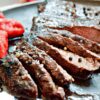How to Make Restaurant-Quality Korean Braised Short Ribs at Home

Korean Braised Short Ribs have long been a favorite dish to order at a restaurant, they are just the right combination of spicy, sweet, savory and totally scrumptious! But, I can’t eat out every night, so when life and low funds get in the way, I make Short Ribs in a slow cooker. The result is an equally delicious, yet homemade dish with beef so tender it falls right off the bone.
While there are several steps to making Korean Braised Short Ribs, it’s easier than you think. In fact, the hardest part of this beef slow cooker recipe, is passing the hours until the timer goes off while having to endure delicious aromas wafting through the house.
The first step to making the most amazing Korean Braised Short Ribs is to use the right cut of beef. It’s important to know that Beef Ribs are butchered in two ways, “Flanken-style” and “English-style.” Flanken-style Short Ribs are ½ inch thick and feature a cross-section cut. While English-style Short Ribs are cut between the ribs, leaving a thick hunk of meat sitting atop a bone.
When braising Short Ribs by any method, including slow cooker, it’s best to use the English-style cut. This prevents having to find and fish out those smaller cross-cut bones when the beef breaks down and falls off the rib during the cooking process. Typically, the meat will fall off the bone of English Short Ribs too, but the bones are larger and easier to remove before serving. However, Flanken-style Short Ribs are great for grilling and delicious Korean Barbecue recipes such as “Kalbi-style” ribs.
Before placing your Short Ribs in the slow cooker, season them with salt and pepper and sear in a heavy-duty skillet lightly-coated with olive oil. Searing beef before braising or slow cooking caramelizes the exposed surfaces, and blooms spices or seasonings, magnifying and adding depth of flavor to the finished dish.
Also adding to the robust, well-rounded flavor of this Korean Short Rib recipe is a delicious “sauce.” This sauce is made with pureed onion, garlic, ginger and Asian pear along other ingredients found in Korean cuisine like soy sauce, rice wine, sesame oil and gochujang – these can all be found in the international aisle of most mainstream, larger supermarkets.
I did learn a few things about the ingredients when making this dish. First, Asian pears look like apples with a greenish-yellow skin and are most easily found in grocery stores from September-January — a Bosc pear makes a good substitute. Second, “rice wine” is not the same thing as “rice wine vinegar” with the later being less sweet and more acidic. If you don’t have a bottle of rice wine sitting around, you can use “Aji-Miren Sweet Rice Wine Cooking Seasoning” (found on the soy sauce aisle), or any dry white wine or most vinegars with a half-teaspoon of additional sugar added. Third, Gochujang is a staple in Korean cooking. It’s a fermented bean paste with red pepper powder added to make it spicy – use more or less according to your tolerance for heat.
After the timer is up and the ribs are fall-apart tender, round out this dish with toasted sesame seeds and serve with brown rice, grilled scallions, shredded carrots or any other vegetable you love and some traditional kimchi. Enjoy!











